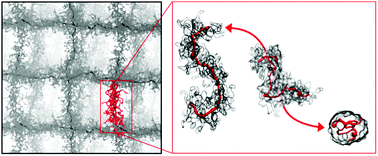Responsive behavior of a branched-chain polymer network: a molecular dynamics study†
Abstract
Smart polymer hydrogels, which can undergo structural and volume phase transitions in response to external stimuli, have gained much attention for their widespread technological applications. Compared to linear polymers, branched chains offer more extensive opportunities to rationally design functional materials, since they permit more extensive structural tunability—for instance by adjusting the balance between hydrophobic and hydrophilic units, the grafting fraction of backbone monomers, or the side chain length, topology, and solubility. Here we conduct coarse-grained molecular dynamics simulations to assess how well generic physical principles capture this complex interplay of tuning parameters, specifically when building networks from complex branched chains with a hydrophobic backbone. Swollen chains collapse upon reducing side chain solubility, length, and grafting density, but neither the sharpness of this transition nor its dynamic range, if measured via chain extension, depends monotonically on these parameters. Networks comprising such chains are more swollen and exhibit even sharper transitions, but their higher responsiveness goes along with a swelling ratio that falls behind that of single chains.



 Please wait while we load your content...
Please wait while we load your content...